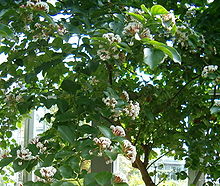Wax trees
| Wax trees | ||||||||||||
|---|---|---|---|---|---|---|---|---|---|---|---|---|

Natal plum ( Carissa macrocarpa ) with flowers and fruits |
||||||||||||
| Systematics | ||||||||||||
|
||||||||||||
| Scientific name | ||||||||||||
| Carissa | ||||||||||||
| L. |


The wax trees ( Carissa ) are a genus of plants in the subfamily of the Rauvolfioideae within the family of the dog poison plants (Apocynaceae).
description
The Carissa species are woody plants that grow independently as upright or climbing shrubs or small trees . They are usually heavily armed with thorns . The branches branch dichotomously, so they fork into roughly equal halves. The opposite leaves have a 2 to 3 mm long petiole.
About terminal or lateral inflorescence shafts usually a few flowers stand together in zymous inflorescences . They are mostly multi-flowered and stalked. The flowers can also appear individually. The mostly hermaphrodite flowers are usually five-fold with a double flower envelope . The petals are fused to form a cylindrical flower tube. The salver-shaped corolla ends in longer corolla lobes that overlap to the left or right. The stamens do not protrude beyond the corolla tube and the anthers are eilanzettlich and blunt or pointed. The upper ovary is two-chambered. One to four ovules in each ovary chamber , rarely many ovules . There is seldom a discus . The one to two-chambered berries contain two or more seeds.
distribution
The Carissa species are native to the tropics and subtropics of Africa , Madagascar , Asia , Australia and New Caledonia . Four types are also found in China .
use
The berries of some species such as the Karanda plum ( Carissa spinarum ) are edible. However, the remaining parts of the plant can be poisonous.
Systematics
The genus Carissa was established in 1767 by Carl von Linné in Systema Naturae , 12th edition, volume 2, pp. 135, 189.. Type species is Carissa carandas L. Synonyms for Carissa L. are: Arduina Mill. Ex L. , Carandas Adans. , Jasminonerium Wolf , Leioclusia Baill. , Toxicophlaea Harv.
The genus Carissa belongs to the tribe Carisseae in the subfamily of the Rauvolfioideae within the family of the Apocynaceae .
The genus Carissa includes 9 about 30 species. Here is the list of the species, with the botanical author abbreviation and the first publication in some cases:
- Carissa andamanensis L.J. Singh & Murugan , Indian J. Forest. 35: 493 (2012): It only occurs in the Andaman Islands.
- Carissa bispinosa (L.) Desf. ex Brenan , Mem. New York Bot. Gard. , 8, 1954, p. 502. (Syn .: Arduina bispinosa L. , Carissa acuminata A.DC. , Carissa arduina Lam. ): It occurs from southeastern Kenya to southern Africa.
- Carissa boiviniana (Baill.) Leeuwenb. , Wageningen Univ. Pap. , 2001, 1, p. 17: It occurs in Madagascar.
- Carissa carandas L. , Mant. Pl. , 1, 1767, p. 52: It is originally found in India and Bangladesh.
- Carissa haematocarpa (Eckl.) A.DC. in APde Candolle, Prodr. 8: 336 (1844): It occurs from southern Namibia to the Cape Province.
- Natal plum ( Carissa macrocarpa ) (Eckl.) A.DC. in APde Candolle: Prodr. , 8, 1844, p. 336. (Syn .: Arduina grandiflora E.Mey. , Arduina macrocarpa Eckl. , Carissa grandiflora (E.Mey.) A.DC. ): It occurs from Kenya to the southeastern Cape Province.
- Carissa pichoniana Leeuwenb. , Wageningen Agric. Univ. Pap. , 97 (2), 1997, p. 101: It occurs in Madagascar.
- Karanda plum ( Carissa spinarum ) L. , Mant. Pl., 2, 1771, p. 559. (Syn .: Carissa edulis (Forssk.) Vahl , Carissa opaca Stapf ex Haines , Carissa ovata R.Br. ): It occurs from Africa to Indochina and from Australia to New Caledonia.
- Carissa tetramera (Sacleux) Stapf in D.Oliver & auct. suc. (eds.): Fl. Trop. Afr. , 4, 1902, p. 91: It occurs from southeastern Kenya to northeastern KwaZulu-Natal.
The following species previously classified in this genus are currently assigned to other genera:
- Carissa oblongifolia Hochst. => Acokanthera oblongifolia (Hochst.) Codd
- Carissa Schimperi A.DC. => Acokanthera schimperi (A.DC.) Olive.
swell
- Bingtao Li, Antony JM Leeuwenberg & David J. Middleton: Apocynaceae , Carissa , p. 146 - online with the same text as the printed work , In: Wu Zheng-yi & Peter H. Raven (eds.): Flora of China , Volume 16 - Gentianaceae through Boraginaceae , Science Press and Missouri Botanical Garden Press, Beijing and St. Louis, 1995, ISBN 0-915279-33-9 . (Section Description and Distribution)
Individual evidence
- ↑ a b c d Bingtao Li, Antony JM Leeuwenberg & David J. Middleton: Apocynaceae , Carissa , p. 146 - online with the same text as the printed work , In: Wu Zheng-yi & Peter H. Raven (eds.): Flora of China , Volume 16 - Gentianaceae through Boraginaceae , Science Press and Missouri Botanical Garden Press, Beijing and St. Louis, 1995, ISBN 0-915279-33-9 .
- ↑ See for example plant profile Carissa macrocarpa at Floridata . (English)
- ↑ Entry in Tropicos . last accessed on January 1, 2012
- ^ A b Carissa in the Germplasm Resources Information Network (GRIN), USDA , ARS , National Genetic Resources Program. National Germplasm Resources Laboratory, Beltsville, Maryland. Retrieved January 1, 2012.
- ↑ a b c d e f g h i j k Rafaël Govaerts (Ed.): Carissa - World Checklist of Selected Plant Families des Royal Botanic Gardens, Kew. Last accessed on November 16, 2018.